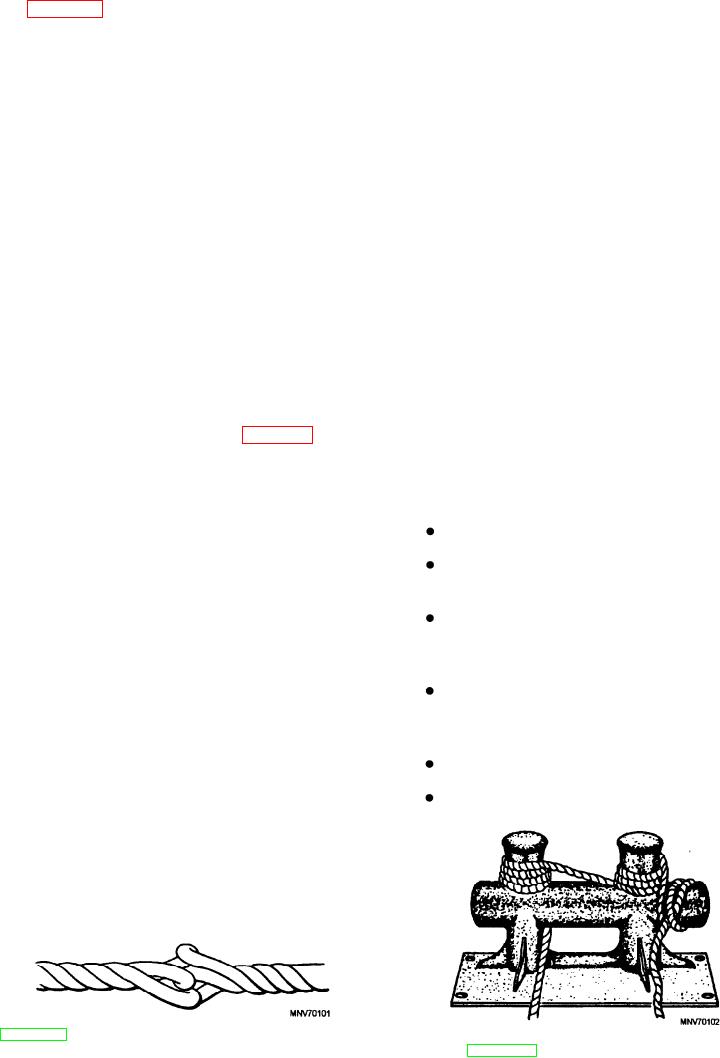
line. Figure 4-5 shows what frequently happens when a
loading conditions. Because of this, it is important that
line with a kink in it is heaved on. The kink, which could
the age of unused lines be determined from the
have been worked out, is now permanent, and the line is
manufacturer's identification marker tape within the
line strand. The marker tape will tell you who made the
ruined.
line, the date the line was made, and the fiber type.
A condition similar to a kink is the cockle (or
hockle), which actually is a kink in an inner yarn that
WARNING
forces the yarn to the surface. When a strain is applied
to a twisted rope with the load free to rotate, the lay of
If natural-fiber line's age exceeds 5 years,
the rope lengthens as the turn runs out of the rope.
do not use the line for critical operations or
Actually, what happens is that the turn is transferred to
operations involving the lives of personnel.
the strands. When the twist in the strand builds to a
Natural-fiber ropes more than 5 years old (even
point where it can take no more, the inside yarns pop
though unused) may only be used for lashing,
through the outer ones. Cockles also can be formed in a
fenders, or matting.
line wound on a capstan or gypsy head in the direction
that tends to unlay the line. You can correct a cockle by
Natural-fiber ropes more than 5 years old (even
stretching the line and twisting the free end to restore the
though unused) may only be used for lashing, fenders,
original lay.
or matting.
Securing lines improperly can cause drastic
It is a good idea to maintain a rigging log to help you
reduction in strength. The strength of a line can be
determine when to remove natural-fiber lines from
reduced by as much as 50 percent for knots and bends
service and replace them with serviceable lines. Unless
and 40 percent for hitches. Figure-eight bends on cleats
you maintain a log, you may have to cut a line open to
and H bitts have the same effect. See figure 4-6 for the
determine its age.
correct way to secure a line on H bitts. When lines are
properly secured with round turns on H bitts, the line
The following are some pointers on the use and care
will retain 90 percent of its strength. When lines are
of natural-fiber and synthetic line. Remember them.
used on double bitts, figure eights reduce the rope
Coil right-laid line right-handed, or clockwise.
strength by only 25 percent.
Deterioration
Keep line from touching stays, guys, and other
standing rigging.
In addition to being damaged by mechanical factors
during service, natural-fiber lines also suffer the effects
When you surge line around bitts or capstans,
of aging under storage conditions. Natural-fiber lines
take off enough turns so the line will not jerk, but
basically consist of cellulose and have the same aging
will surge smoothly.
properties as paper. That is, they turn yellow or brown
and become brittle with time, even under the best
If line becomes chafed or damaged, cut out the
storage conditions. The color change indicates that the
damage and splice the line. A good splice is safer
line has lost breaking strength (BS). The loss usually
than a damaged section.
amounts to 1 to 2 percent per year of storage.
Do not lubricate line.
However, BS is not a true index of the line's utility.
More important is the loss of bending strength,
Whip all line ends.
indicated by the fibers' becoming brittle and stiff.
Bending strength decreases five times as rapidly as BS.
Deterioration of bending strength causes the fibers to
rupture easily when bent over sheaves or other holding
devices. Once deterioration begins, the line breaks
down with each successive bend, even under light
Figure 4-5.--Result of a strong strain on a line with a kink in
Figure 4-6.--Securing lines to H bitts.
it.
4-4

